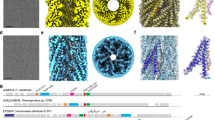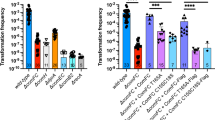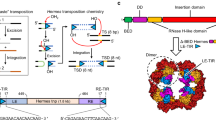Abstract
The transfer of DNA across membranes and between cells is a central biological process; however, its molecular mechanism remains unknown. In prokaryotes, trans-membrane passage by bacterial conjugation, is the main route for horizontal gene transfer. It is the means for rapid acquisition of new genetic information, including antibiotic resistance by pathogens. Trans-kingdom gene transfer from bacteria to plants1 or fungi2 and even bacterial sporulation3 are special cases of conjugation. An integral membrane DNA-binding protein, called TrwB in the Escherichia coli R388 conjugative system, is essential for the conjugation process. This large multimeric protein is responsible for recruiting the relaxosome DNA–protein complex, and participates in the transfer of a single DNA strand during cell mating. Here we report the three-dimensional structure of a soluble variant of TrwB. The molecule consists of two domains: a nucleotide-binding domain of α/β topology, reminiscent of RecA and DNA ring helicases, and an all-α domain. Six equivalent protein monomers associate to form an almost spherical quaternary structure that is strikingly similar to F1-ATPase. A central channel, 20 Å in width, traverses the hexamer.
This is a preview of subscription content, access via your institution
Access options
Subscribe to this journal
Receive 51 print issues and online access
$199.00 per year
only $3.90 per issue
Buy this article
- Purchase on Springer Link
- Instant access to full article PDF
Prices may be subject to local taxes which are calculated during checkout


Similar content being viewed by others
References
Stachel, S. E. & Zambryski, P. Agrobacterium tumefaciens and the susceptible plant cell: a novel adaptation of extracellular recognition and DNA conjugation. Cell 47, 155–157 (1986).
Heinemann, J. A. & Sprague, G. F. J. Bacterial conjugative plasmids mobilize DNA transfer between bacteria and yeast. Nature 340, 205–209 (1989).
Wu, L. J., Lewis, P. J., Allmansberger, R., Hauser, P. M. & Errington, J. A conjugation-like mechanism for prespore chromosome partitioning during sporulation in Bacillus subtilis. Gene Dev. 9, 1316–1326 (1995).
Llosa, M., Bolland, S. & de la Cruz, F. Genetic organization of the conjugal DNA processing region of the IncW plasmid R388. J. Mol. Biol. 235, 448–464 (1994).
Moncalián, G. et al. Characterization of ATP and DNA binding activities of TrwB, the coupling protein essential in plasmid R388 conjugation. J. Biol. Chem. 274, 36117–36124 (1999).
Zechner, E. L. in The Horizontal Gene Pool: Bacterial Plasmids and Gene Spread (ed. Thomas, C. M.) 87–173 (Harwood Academic, London, 2000).
Cabezón, E., Sastre, J. I. & de la Cruz, F. Genetic evidence of a coupling role for the TraG protein family in bacterial conjugation. Mol. Gen. Genet. 254, 400–406 (1997).
Begg, K. J., Dewar, S. J. & Donachie, W. D. A new Escherichia coli cell division gene, ftsK. J. Bacteriol. 177, 6211–6222 (1995).
Walker, J. E., Saraste, M., Runswick, M. J. & Gay, N. J. Distantly related sequences in the α- and β-subunits of ATP synthase, myosin, kinases and other ATP-requiring enzymes and a common nucleotide binding fold. EMBO J. 1, 945–951 (1982).
Abrahams, J. P., Leslie, A. G. W., Lutter, R. & Walker, J. E. Structure at 2.8 Å resolution of F1-ATPase from bovine heart mitochondria. Nature 370, 621–628 (1994).
Singleton, M. R., Sawaya, M. R., Ellenberger, T. & Wigley, D. B. Crystal structure of T7 gene 4 ring helicase indicates a mechanism for sequential hydrolysis of nucleotides. Cell 101, 589–600 (2000).
Story, R. M., Weber, I. T. & Steitz, T. A. The structure of the E.coli recA protein monomer and polymer. Nature 355, 318–325 (1992).
Sawaya, M. R., Guo, S., Tabor, S., Richardson, C. C. & Ellenberger, T. Crystal structure of the helicase domain from the replicative helicase-primase of bacteriophage T7. Cell 99, 167–177 (1999).
Guenther, B., Onrust, R., Sali, A., O'Donnell, M. & Kuriyan, J. Crystal structure of the δ′ subunit of the clamp-loader complex of E.coli DNA polymerase III. Cell 91, 335–345 (1997).
Lenzen, C. U., Steinmann, D., Whiteheart, S. W. & Weis, W. I. Crystal structure of the hexamerization domain of N-ethylmaleimide-sensitive fusion protein. Cell 94, 525–535 (1998).
Subramanya, H. S., Bird, L. E., Brannigan, J. A. & Wigley, D. B. Crystal structure of a DExx box DNA helicase. Nature 384, 379–383 (1996).
Subramanya, H. S. et al. Crystal structure of the site-specific recombinase, XerD. EMBO J. 16, 5178–5187 (1997).
Egelman, E. H., Yu, X., Wild, R., Hingorani, M. M. & Patel, S. M. Bacteriophage T7 helicase/primase proteins form rings around single-stranded DNA that suggest a general structure for hexameric helicases. Proc. Natl Acad. Sci. USA 92, 3869–3873 (1995).
Hacker, K. J. & Johnson, K. A. A hexameric helicase encircles one DNA strand and excludes the other during DNA unwinding. Biochemistry 36, 14080-14087 (1997).
Yu, X., Hingorani, M. M., Patel, S. S. & Egelman, E. H. DNA is bound within the central hole to one or two of the six subunits of the T7 DNA helicase. Nature Struct. Biol. 3, 740–743 (1996).
Soultanas, P. & Wigley, D. B. DNA helicases: ‘inching forward’. Curr. Opin. Struct. Biol. 10, 124–128 (2000).
Raney, K. D. & Benkovic, S. J. Bacteriophage T4 DDA helicase translocates in an unidirectional fashion on single-stranded DNA. J. Biol. Chem. 270, 22236–22242 (1995).
Kaplan, D. L. The 3′-tail of a forked-duplex sterically determines whether one or two DNA strands pass through the central channel of a replication-fork helicase. J. Mol. Biol. 301, 285–299 (2000).
Leslie, A. G. W. in Crystallographic computing V (eds Moras, D., Podjarny, A. D. & Thierry, J. C.) 27–38 (Oxford Univ. Press, Oxford, 1991).
CCP4. The CCP4 suite: programs for protein crystallography. Acta Crystallogr. D 50, 760–763 (1994).
Sheldrick, G. M. Patterson superposition and ab initio phasing. Methods Enzymol. 276, 628–641 (1997).
Brünger, A. T. et al. Crystallography & NMR System: a new software suite for macromolecular structure determination. Acta Crystallogr. D 54, 905–921 (1998).
Navaza, J. AMoRe: an automated package for molecular replacement. Acta Crystallogr. A 50, 157–163 (1994).
Evans, S. V. SETOR: hardware lighted three-dimensional solid model representations of macromolecules. J. Mol. Graphics 11, 134–138 (1993).
Nicholls, A., Bharadwaj, R. & Honig, B. GRASP: graphical representation and analysis of surface properties. Biophys. J. 64, A166–A166 (1993).
Sastre, J. I., Cabezon, E. & de la Cruz, F. The carboxyl terminus of protein TraD adds specificity and efficiency to F-plasmid conjugative transfer. J. Bacteriol. 180, 6039–6042 (1998).
Acknowledgements
We are most grateful to R. Huber for making tantalum bromide available to us, and to I. Usón for help with SHELX. This work was supported by grants from the Ministerio de Educación y Cultura of Spain, the Generalitat de Catalunya and the European Union. Synchrotron data collection was supported by EU grants and the ESRF.
Author information
Authors and Affiliations
Corresponding author
Rights and permissions
About this article
Cite this article
Gomis-Rüth, F., Moncalián, G., Pérez-Luque, R. et al. The bacterial conjugation protein TrwB resembles ring helicases and F1-ATPase. Nature 409, 637–641 (2001). https://doi.org/10.1038/35054586
Received:
Accepted:
Issue Date:
DOI: https://doi.org/10.1038/35054586
This article is cited by
-
Structural and functional diversity of type IV secretion systems
Nature Reviews Microbiology (2024)
-
ICEKp2: description of an integrative and conjugative element in Klebsiella pneumoniae, co-occurring and interacting with ICEKp1
Scientific Reports (2019)
-
Development of TEM-1 β-lactamase based protein translocation assay for identification of Anaplasma phagocytophilum type IV secretion system effector proteins
Scientific Reports (2019)
-
The Rich Tapestry of Bacterial Protein Translocation Systems
The Protein Journal (2019)
-
Legionella DotM structure reveals a role in effector recruiting to the Type 4B secretion system
Nature Communications (2018)
Comments
By submitting a comment you agree to abide by our Terms and Community Guidelines. If you find something abusive or that does not comply with our terms or guidelines please flag it as inappropriate.



